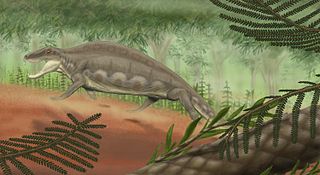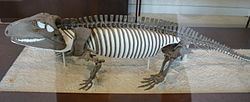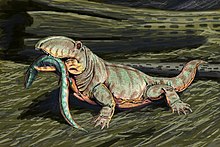
Synapsida is one of the two major clades of vertebrate animals in the group Amniota, the other being the Sauropsida. The synapsids were the dominant land animals in the late Paleozoic and early Mesozoic, but the only group that survived into the Cenozoic are mammals. Unlike other amniotes, synapsids have a single temporal fenestra, an opening low in the skull roof behind each eye orbit, leaving a bony arch beneath each; this accounts for their name. The distinctive temporal fenestra developed about 318 million years ago during the Late Carboniferous period, when synapsids and sauropsids diverged, but was subsequently merged with the orbit in early mammals.

Edaphosauridae is a family of mostly large Late Carboniferous to Early Permian synapsids. Edaphosaur fossils are so far known only from North America and Europe.

Sphenacodontia is a stem-based clade of derived synapsids. It was defined by Amson and Laurin (2011) as "the largest clade that includes Haptodus baylei, Haptodus garnettensis and Sphenacodon ferox, but not Edaphosaurus pogonias". They first appear during the Late Pennsylvanian epoch. From the end of the Carboniferous to the end of the Permian, most of them remained large, with only some secondarily becoming small in size.

Eupelycosauria is a large clade of animals characterized by the unique shape of their skull, encompassing all mammals and their closest extinct relatives. They first appeared 308 million years ago during the Early Pennsylvanian epoch, with the fossils of Echinerpeton and perhaps an even earlier genus, Protoclepsydrops, representing just one of the many stages in the evolution of mammals, in contrast to their earlier amniote ancestors.

Caseasauria is one of the two main clades of early synapsids, the other being the Eupelycosauria. Caseasaurs are currently known only from the Late Carboniferous and the Permian, and include two superficially different families, the small insectivorous or carnivorous Eothyrididae, and the large, herbivorous Caseidae. These two groups share a number of specialised features associated with the morphology of the snout and external naris.

Archaeothyris is an extinct genus of ophiacodontid synapsid that lived during the Late Carboniferous and is known from Nova Scotia. Dated to 306 million years ago, Archaeothyris, along with a more poorly known synapsid called Echinerpeton, are the oldest undisputed synapsids known. The name means ancient window (Greek), and refers to the opening in the skull, the temporal fenestra, which indicates this is an early synapsid. Protoclepsydrops also from Nova Scotia is slightly older but is known by very fragmentary materials.
Varanopidae is an extinct family of amniotes that resembled monitor lizards and may have filled a similar niche, hence the name. Typically, they are considered synapsids that evolved from an Archaeothyris-like synapsid in the Late Carboniferous. However, some recent studies have recovered them being taxonomically closer to diapsid reptiles. A varanopid from the latest Middle Permian Pristerognathus Assemblage Zone is the youngest known varanopid and the last member of the "pelycosaur" group of synapsids.

Sphenacodontoidea is a node-based clade that is defined to include the most recent common ancestor of Sphenacodontidae and Therapsida and its descendants. Sphenacodontoids are characterised by a number of synapomorphies concerning proportions of the bones of the skull and the teeth.

Ophiacodon is an extinct genus of synapsid belonging to the family Ophiacodontidae that lived from the Late Carboniferous to the Early Permian in North America and Europe. The genus was named along with its type species O. mirus by paleontologist Othniel Charles Marsh in 1878 and currently includes five other species. As an ophiacodontid, Ophiacodon is one of the most basal synapsids and is close to the evolutionary line leading to mammals.

Haptodus is an extinct genus of basal sphenacodont, member of the clade that includes therapsids and hence, mammals. It was at least 1.5 metres (5 ft) in length. It lived in present-day France during the Early Permian. It was a medium-sized predator, feeding on insects and small vertebrates.

Clepsydrops is an extinct genus of primitive synapsids from the early Late Carboniferous that was related to Archaeothyris. The name means 'hour-glass appearance'.

Varanosaurus is an extinct genus of early ophiacodontid synapsid that lived during the Artinskian and Kungurian ages of the Permian.
Casea is a genus of herbivorous caseid synapsids that lived during the late Lower Permian (Kungurian) in what is now Texas, United States. The genus is only represented by its type species, Casea broilii, named by Samuel Wendell Williston in 1910. The species is represented by a skull associated with a skeleton, a second skull, a partial skull with a better preserved dentition than that of the preceding skulls, and several incomplete postcranial skeletons. Three other Casea species were later erected, but these are considered today to be invalid or belonging to different genera. Casea was a small animal with a length of about 1.20 m and a weight of around 20 kg.

Ctenorhachis is an extinct genus of the family Sphenacodontidae. Ctenorhachis lived in the Early Permian epoch. Ctenorhachis was related to Dimetrodon, but did not belong to the same subfamily as Dimetrodon and Sphenacodon, being a more basal member of Sphenacodontidae. Two specimens are known that have been found from the Wichita Group outcropping in Baylor and Archer counties, north-central Texas. Only the vertebrae and pelvis are known. Articulated vertebrae from the holotype specimen possess blade like neural spines that are greatly enlarged, although not nearly to the extent that can be seen in more derived sphenacodontids such as Dimetrodon and Secodontosaurus, in which they form a large sail. The pelvis is nearly identical to that of Dimetrodon. As suggested in the original description of the genus, Ctenorhachis may represent a short-spined sexual dimorph, although the authors find this unlikely.

Limnoscelis was a genus of large diadectomorph tetrapods from the Late Carboniferous to early Permian of western North America. It includes two species: the type species Limnoscelis paludis from New Mexico, and Limnoscelis dynatis from Colorado, both of which are thought to have lived concurrently. No specimens of Limnoscelis are known from outside of North America. Limnoscelis was carnivorous, and likely semiaquatic, though it may have spent a significant portion of its life on land. Limnoscelis had a combination of derived amphibian and primitive reptilian features, and its placement relative to Amniota has significant implications regarding the origins of the first amniotes.

Pantelosaurus is an extinct genus of basal sphenacodonts known from the Early Permian period of Saxony, Germany. It contains a single species, Pantelosaurus saxonicus.

Echinerpeton is an extinct genus of synapsid, including the single species Echinerpeton intermedium from the Late Carboniferous of Nova Scotia, Canada. The name means 'spiny lizard' (Greek). Along with its contemporary Archaeothyris, Echinerpeton is the oldest known synapsid, having lived around 308 million years ago. It is known from six small, fragmentary fossils, which were found in an outcrop of the Morien Group near the town of Florence. The most complete specimen preserves articulated vertebrae with high neural spines, indicating that Echinerpeton was a sail-backed synapsid like the better known Dimetrodon, Sphenacodon, and Edaphosaurus. However, the relationship of Echinerpeton to these other forms is unclear, and its phylogenetic placement among basal synapsids remains uncertain.

Ianthodon is an extinct genus of basal haptodontiform synapsids from the Late Carboniferous about 304 million years ago. The taxon was discovered and named by Kissel & Reisz in 2004. The only species in the taxon, Ianthodon schultzei, was found by separating it from a block that also contained the remains of Petrolacosaurus and Haptodus. The evolutionary significance of the taxon wasn't realized until a publication in 2015. The fossil of this organism was discovered in Garnett, Kansas.

Cutleria is an extinct genus of basal sphenacodontids or derived stem-sphenacodontoid known from the Early Permian period of Colorado, United States. It contains a single species, Cutleria wilmarthi.























